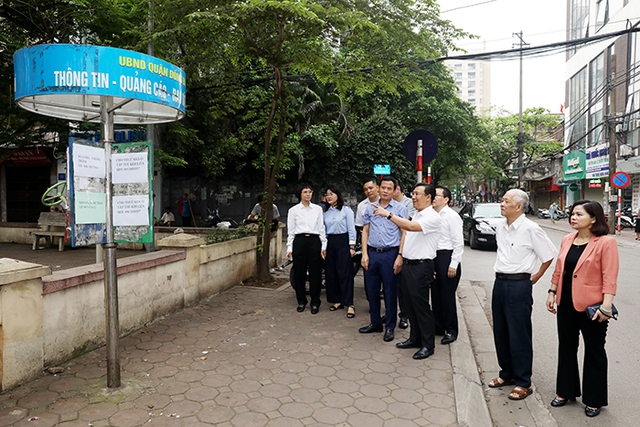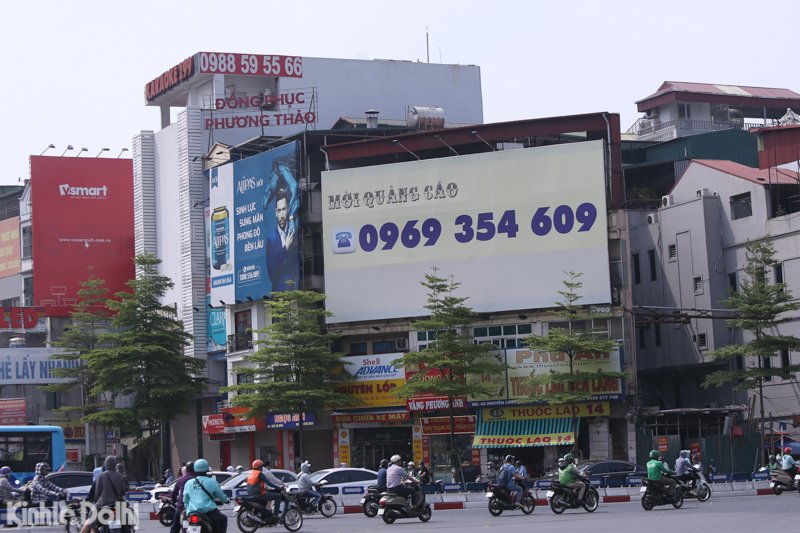
Hanoi has strengthened citywide legal regulations on advertising since 2018 with the latest regulations issued in April 2024 to tighten control over advertising displays, especially outdoor advertising.
Meanwhile, some districts have held conferences to disseminate laws on advertising, conducted inspections, and dealt with infringements related to outdoor advertising throughout the city to ensure urban civilized order and synchronously beautify streets.
In Dong Da District, with a high population density and many private businesses, there is a large amount of outdoor advertising. The district government plans to install 24 free billboards in 21 wards.
Hanoi authorities inspect outdoor advertising in Dong Da district. Photo: VGP |
The supervision team assessed that Dong Da is a district with high-populated density and many private businesses, so activities related to promotion and advertising are dense. The district’s authority has fulfilled its management, reviewed and organized measures to ensure advertising activities in accordance with the law.
Since 2018, authorities have removed around 460 illegal billboards and more than 14,000 banners hanging on trees, electricity poles, and shops. More than 30 businesses that installed illegal billboards have been fined a total of over VND150 million (US$5,900).
Other districts like Hai Ba Trung, Thuong Tin, Dan Phuong have also handled thoroughly illegal advertising activities. The districts have enhanced communication activities to raise awareness for organizations, individuals, and businesses in the area; held an emulation campaign to "keep villages bright, green, clean, beautiful, and safe"; strengthened management, periodic and irregular inspection of advertising activities to strictly handle violations.
According to the Hanoi Department of Culture and Sports, the management of advertising activities is always considered a key task. There are currently more than 11,880 advertising boards in the capital. From 2018 to the first quarter of 2024, the department has inspected and dealt with hundreds of advertising violations, imposing fines totaling over VND6.8 billion ($267,480).
Common offences include oversized billboards, unauthorised billboard placement or content, and businesses deliberately distributing more flyers than permitted. Current regulations allow businesses to display approximately 20-50 flyers or posters for each music show, trade fair or exhibition. However, the actual number of posters and flyers displayed is usually higher.
Over the past six years, the Hanoi Department of Information and Communication has focused on cracking down on the advertising of prohibited products and services. By reviewing 253 online sites, the department has compiled 92 units that violated advertising laws.
The department used the Brand Name Identification Message System to send 650 messages to summon offenders, dealt with eight organisations and five individuals for spam messages and calls, and asked telecommunication operators to suspend services to over 4,870 phone numbers making illegal advertisements. The department coordinated with district People's Committees to impose administrative fines of over VND240 million ($9,440) on more than 150 subscribers making spam calls.
O Cho Dua, an intersection in Hanoi with a high density of billboards. Photo: Ngoc Tu/The Hanoi Times |
Hanoi pioneers in tightening control of advertising displays
In 2018, the city developed major plans called 'Planning of Outdoor Advertising Panels to 2020 with an Orientation to 2030' and 'Regulations on Outdoor Advertising Activities' to regulate the installation of outdoor advertising billboards in Hanoi and address unauthorised outdoor advertising.
Surveys by Ky Nguyen Advertising and Event JSC, the company responsible for developing the first draft, showed that outdoor advertising in Hanoi was almost out of control. Most outdoor billboards did not comply with national regulations on size, location or licensing, leading to a higher risk of traffic accidents and explosions.
According the above plan, outdoor advertising panels have to follow set sizes. Smaller billboards will be banned from overpass bridges, bridges across the Red River and historical and cultural parks. The plan requires all advertising banners to be the same size and only hung in one of 14,000 approved areas.
The Hanoi Department of Culture, Sports and Tourism stressed that the disorder of outdoor advertising has scarred the urban landscape, producing the so-called "urban trash". More advertising space means less green space left in the capital city.
The city has designated areas where advertising is prohibited, including Ba Dinh Square, around Hoan Kiem Lake, the Old Quarter, offices of Party, State, and government agencies, police stations, embassies, and headquarters of international organizations.
Advertising has been restricted in places such as August 19 Square in front of the Hanoi Opera House, the National Convention Center and the city's major lakes. The plans also regulated advertising on private buildings and houses. Such places saw many advertising violations in times past, and violations were difficult to address.
Billboards are not allowed to be mounted on buildings or obscuring the roof. Billboards on building facades must be less than two meters high and not wider than the width of the building.
Each office or shop can display its name on only one sign. Such signs are limited to a maximum height of two meters if the sign is horizontal, or a maximum height of four meters if the sign is vertical.




